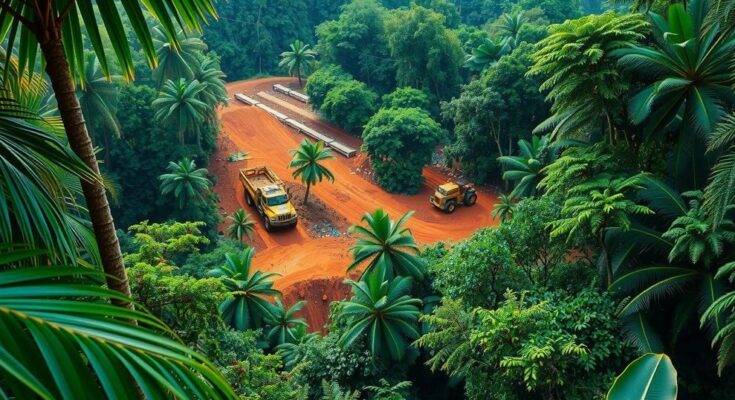Research reveals that gold mining in Peru’s Amazon drastically harms peatlands, crucial carbon sinks, releasing significant carbon emissions and contributing to climate change. Illegal mining operations threaten the delicate ecosystems of the Madre de Dios region, where employment has risen amid ongoing economic challenges.
Gold mining in the Amazon rainforest of Peru is having devastating environmental repercussions, as highlighted in a recent study. This research indicates that small-scale gold mining contributes significantly to the destruction of peatlands, which are critical carbon sinks. In the Madre de Dios region, approximately 70 percent of Peru’s artisanal gold production occurs, primarily providing employment for about 30,000 individuals, a number that has surged due to economic instability since the 2008 financial crisis.
The majority of mining activities in this area are illegal and have been identified as major contributors to regional deforestation. The recent findings underline the additional environmental threat posed by these operations: the rapid destruction of Amazonian peatlands. These ecosystems, comprised of waterlogged plant material, are vital as they represent dense carbon reservoirs, storing seven times more carbon than the local trees. However, extensive mining is leading to significant carbon emissions as these peatlands are disturbed.
Research leveraging over 35 years of NASA Landsat satellite data reveals a loss of more than 550 hectares (approximately 1,359 acres) of peatland, resulting in the release of between 0.2 to 0.7 million tons of carbon. Alarmingly, over half of this destruction has occurred within the last two years. Although only 9 percent of the current mining occurs in peatlands, this is projected to increase, potentially escalating to 25 percent by 2027, with a predicted carbon release of up to 14.5 million tons, which is comparable to the annual emissions from millions of cars.
Dr. John Householder, the study’s corresponding author from the Karlsruhe Institute of Technology, emphasized the urgent need for protective measures, stating, “Mining is spreading fast into these fragile areas… If we do not slow down the destruction, the damage to the Amazon’s peatlands could be permanent.” He also pointed out the alarming rate at which peat deposits are vanishing, stressing that scientific understanding must catch up before irreversible damage is done.
The challenge in tracing gold sourced from the peatlands lies in its extraction by unregulated groups, making it virtually untraceable as it circulates through local traders and middlemen before reaching global markets. Despite Peru being one of the world’s leading gold producers, a substantial portion of its production, often illegal, is likely derived from these delicate peat ecosystems, now largely overlooked in terms of conservation efforts.
The ongoing small-scale gold mining in the Peruvian Amazon’s Madre de Dios region is wreaking havoc on vital peatland ecosystems, releasing immense quantities of carbon and contributing to climate change. The implications of unchecked illegal mining pose serious risks not only to the environment but also to the local economy and society. Urgent actions to enforce regulations and protect these critical landscapes are imperative to mitigate further damage.
Original Source: www.newsbreak.com




